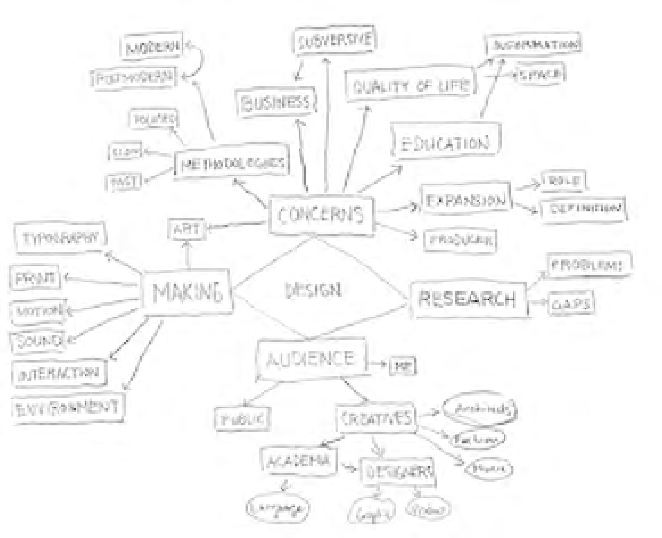Graphics Reference
In-Depth Information
12-5
Polar opposition occurs in both the syntactic
and semantic realms. In this example, the letters
S
and
T
stand syntactically in opposition in terms
of shape and weight. The lightness and solitude
of peace stand in opposition to the heaviness and
aggressiveness of war.
Brainstorming.
Brainstorming is perhaps the most familiar
ideation strategy for design teams. Though it has its detractors, it
remains an effective approach if conducted according to basic ground
rules. These include deferring judgment of all ideas during a session,
generating as many ideas as possible, and being open to both good
and bad ideas. The basic theory is that the group is a deep reservoir of
experience, and that one idea leads to new and unique possibilities.
Mind mapping.
Related to free association, mind mapping is a
nonlinear brainstorming process with a word or concept at its nucleus.
By making lighting-quick associations of the concept, a web of related
themes reflecting mental patterns emerges (Fig.
12-4
). The satellite
concepts generated from mind mapping help designers identify areas
of possible content, both visual and verbal.
Word lists and interaction matrix structures.
Making lists of
analogous words and descriptive phrases related to specific umbrella
topics, or spontaneously generating random words derived from
brainstorming or mind mapping, can stimulate thinking and open the
mind to broader visual possibilities. When lists of words are integrated
into the structure of a matrix, new and improbable relationships can
be forged between unlikely and contrasting word pairs. Often the most
intriguing concepts emerge from the interaction of polar or nearly
polar opposites. A sign is understood more clearly and achieves greater
impact when juxtaposed with an opposite sign (Fig.
12-5
). Interaction
matrix structures can also accommodate the interaction of words
with images, or images with other images. Collecting an abundance
of material related to given content and applying it to an interaction
matrix can aid the designer in identifying and defining a problem,
or in developing fresh ideas outside of conventional thinking. When
engaging in these processes, it is helpful to unleash the play instinct,
release the child within, and hush any tendency toward self-criticism.
In the sample matrix structure, the red dots are placed at points of
potential interaction (Fig.
12-6
).
Visual notations and comprehensives.
Ideas that remain in the
mind and are not articulated visually do little to move the process ahead.
Design students often convey their ideas to teachers and classmates
verbally. This is where ideas begin, but until they are expressed visually
in the form of sketches or notations, their effectiveness cannot be
evaluated. Thumbnail notations can be created with a variety of tools
and materials, from pencil and paper to computer.
The design process can be thought of as beginning at the broad
base of a pyramid. Options are expansive at first, but as one moves
through the pyramid toward its apex, the vision of a viable outcome—
the solution to a problem—becomes more specific. The process may
begin as a mind-mapping session, progress into a series of general
notations, and then advance to comprehensive sketches. A project
conducted at Rutgers University by Professor Ned Drew is used to
illustrate this progression. Visual notations and sketches leading to the
design of banknotes are shown (Figs.
12-7 to 12-13
; see also Figs. 11-60
and 11-61).
12-4
Any subject can serve as the nucleus for a mind
map. Mind mapping is an invaluable exercise wherein
the designer's thought processes are revealed as an
ever-expanding universe of possibility and potential.
(Designer: Matt Klimas)
fear
courage
hate
lust
resentment
anger
trust
seduction
happiness
frustration
12-6



































